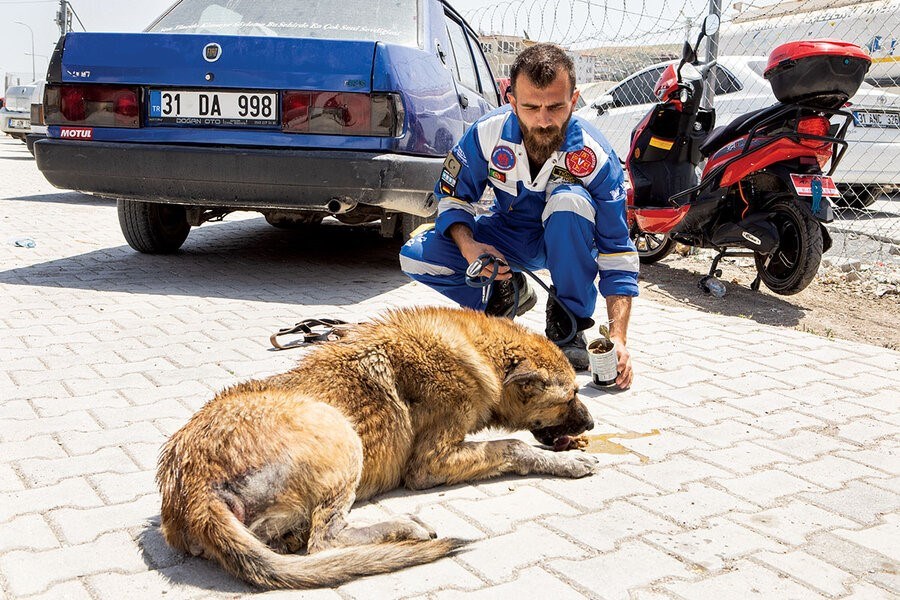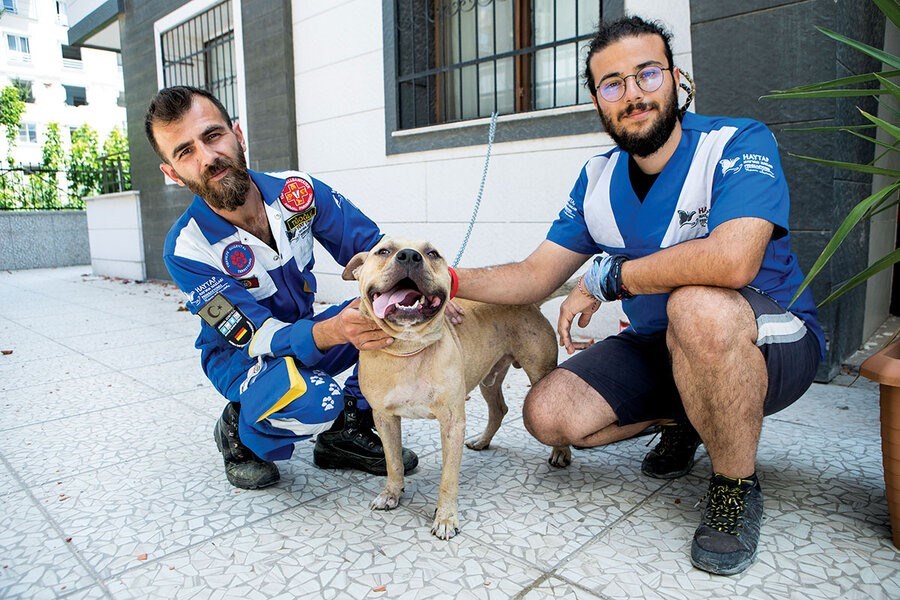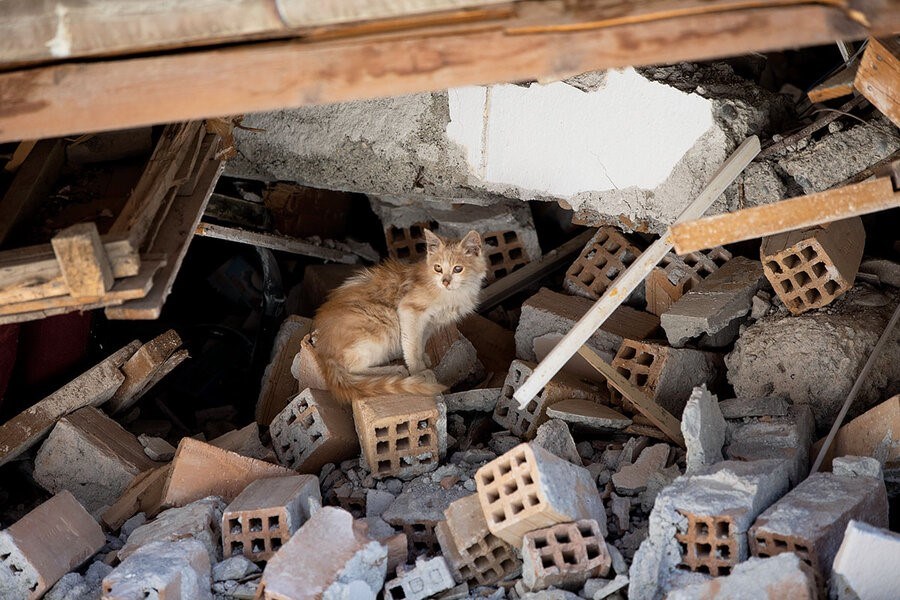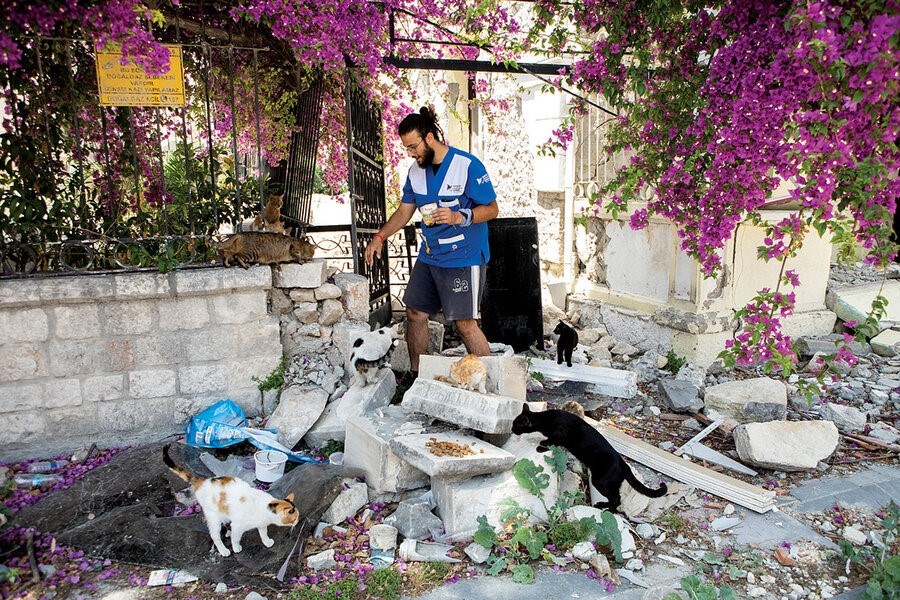REPRINTED WITH PERMISSION FROM THE CHRISTIAN SCIENCE MONITOR
 Mehmet Gürkan Tığoğlu gives a stray dog with mites some food in Antakya, Turkey, on May 26, 2023. Melanie Stetson Freeman/Staff
Mehmet Gürkan Tığoğlu gives a stray dog with mites some food in Antakya, Turkey, on May 26, 2023. Melanie Stetson Freeman/Staff
July 10, 2023
The dog’s golden coat should be shiny. It should be soft. But it’s matted and slicked with what turns out to be engine oil.
Mehmet Gürkan Tığoğlu arrives on the scene – the perimeter of a “container city” erected after the devastating earthquake Feb. 6 that leveled the ancient city of Antakya in southern Turkey.
He had received a call – one of dozens that make his phone buzz daily – about a dog in distress. So he suited up in his blue uniform for Haytap, the name of the Turkish animal rescue organization he’s been volunteering for in the quake’s aftermath.
Mr. Tığoğlu doesn’t warm up quickly in human interaction – although he eventually does – but with animals it’s immediate. “Hey baby,” he says, calming the male dog down, leashing and muzzling him, and putting him in the back of his pickup truck until he can find him some relief.
The work of animal rescue after a disaster is uniquely taxing. Amid high death tolls – in this case at least 50,000 people across Turkey and Syria – animals are often an afterthought. “People say I’m the crazy one,” he says. But he says he is not indifferent to the needs of humans.
After the earthquake, he helped rescue them, too. It’s just that he is as keenly aware of the deprivation of the stray cats and dogs and injured hawks and donkeys that are stuck in rubble, struck by cars, separated from their mothers, injured, dehydrated, or starving now. “We domesticated them; now we can’t leave them by themselves. This is what we did to them, so this is what we have to do for them,” he says.
 Melanie Stetson Freeman/StaffMehmet Gürkan Tığoğlu (left) and Hakan Tanriover pet a pit bull they brought in. Both men have worked to save animals in the aftermath of the February earthquake in Turkey that killed more than 50,000 people.
Melanie Stetson Freeman/StaffMehmet Gürkan Tığoğlu (left) and Hakan Tanriover pet a pit bull they brought in. Both men have worked to save animals in the aftermath of the February earthquake in Turkey that killed more than 50,000 people.
Much of the focus on animals after disaster happens in the immediate days following, when pets are separated from their owners, says Felipe Marquez of the Humane Society International in Mexico. He was deployed to Antakya the week after the earthquake, helping to rescue dogs, cats, bunnies, reptiles, and even a bowl of goldfish that remained intact while the residence around it had been destroyed.
“This work is so important,” he says. “Imagine a person who has lost everything. To find their pet gives them one small hope, so that they can continue surviving.”
But then the “feel-good” stories end, and media attention wanes. Ownerless pets roam the streets, and a fragile society is taxed as needs mount. Sometimes survivors can no longer afford to care for their pets. Animals, well loved in Turkey, become a nuisance, another challenge at an unbelievably challenging time. And international rescue crews leave.
That’s when the steady hand and constant presence of Mr. Tığoğlu, who eschews the term “animal lover” or “animal activist,” becomes key. “We would not know how to continue to work there without Mehmet’s support,” says Tom Terveer, who, along with his wife, Babette, was one of the co-founders of the German animal rescue group Notpfote (or “Paw in Need” in English), which financially supports Haytap’s rescue work. “He is the last frontier between life and death for most of the animals there. He’s doing everything for the animals.”
 Melanie Stetson Freeman/StaffA young street cat climbs in the rubble in the old part of Antakya, Turkey. The historic city suffered massive destruction in the wake of the February earthquake.
Melanie Stetson Freeman/StaffA young street cat climbs in the rubble in the old part of Antakya, Turkey. The historic city suffered massive destruction in the wake of the February earthquake.
“You can only cry about what has happened in Antakya,” says Ms. Terveer, who has been working on animal rescue in Ukraine but has visited Turkey alongside Mr. Terveer 10 times since the earthquake. “Those people are forgotten; the animals are forgotten.”
Mr. Tığoğlu and other rescuers have entered about 400 destroyed buildings since Feb. 6, saving roughly 2,000 animals, often at great danger to themselves, especially as aftershocks continue.
In the early days, Mr. Marquez says pet owners recorded their voices on his phone, and he’d walk around damaged buildings playing the recordings to lure their animals out. Today Mr. Tığoğlu drives through the devastated town with a recording of a kitten calling its mother to draw stray cats out to make sure they’re getting enough food.
The other day he and Hakan Tanriover, a young Turkish man volunteering at Mr. Tığoğlu’s side, helped escort several cows out from rubble in the hills of Hatay province, building a tunnel to guide them – not just a humane gesture, but also central to the economy of families who have no other income. It took 10 hours. Mr. Tığoğlu often takes calls in the middle of the night. “Everyone has his number,” says Mr. Tanriover.
 Melanie Stetson Freeman/StaffHakan Tanriover feeds street cats wet and dry food in the old town of Antakya, Turkey.
Melanie Stetson Freeman/StaffHakan Tanriover feeds street cats wet and dry food in the old town of Antakya, Turkey.
The dog he has helped rescue today has mange. An unknowing local resident thought that oil would kill the mites, but it only made a hungry and dehydrated animal more agitated. He and Mr. Tanriover take him – Mr. Tığoğlu never names an animal, but the ever-cheerful Mr. Tanriover does, already naming two dogs that week Molly and Pirate – to a desolate patio where a rescued pit bull is also living, until they can find a long-term solution.
“They need a field where they can touch the earth, but this is the best we can do for now,” Mr. Tanriover says. “These animals can’t find water; they can’t even find dirty water.”
Later, they visit the city’s animal shelter, where dogs are separated by gender, size, and need: mothers with pups, young dogs, big male dogs. Mr. Tığoğlu refuses to enter because he knows he can’t help them now, and that’s too hard to bear.
He has done the work of animal rescue after floods, wildfires, and other earthquakes in Turkey. But he says he has never seen destruction on this scale. He has no plans to leave. “I see two roads. The first is giving up and stopping caring,” he says. “The second is to continue on, to not feel sorry for the ones you could not rescue, but to be proud of the ones that you did rescue and that are still alive.”
Related stories
Page created on 7/17/2023 11:36:31 AM
Last edited 7/17/2023 11:51:00 AM
